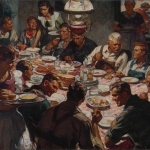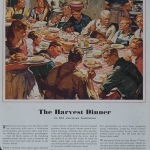The Heinz ketchup advertisement this illustration by Saul Tepper was created to accompany is titled, The Harvest Dinner: An Old American Institution. Tepper’s original painting shows a group of more than thirteen sun-tanned farmers seated at a large table talking, flirting, and most importantly eating, or getting ready to eat their evening meal after a long day of harvesting. We can tell it is evening because the lamp hanging over the table is lit and through the room’s window we see a night sky. Around the table women move delivering plates or food to the hungry men. In the background we can see an older woman still working at the stove.
The composition recedes diagonally from right to left in the space of the painted picture. This gives the interior space some depth and allows us to feel that everyone in the painted space might really be accommodated if this room was actually real. The men at the table engage in various activities: some concentrate on their meal; some talk with their neighbors; some look at the women serving the food; and one pair, an older man and younger boy, give the impression that some sort of lesson is gently being shared across the generations.
It is interesting that the Heinz Company’s ad text indicates that harvest dinner happens at noon: “. . . at noontide the clang of the farm bell calls all hands to the harvest dinner.” The ad goes on to claim that this dinner is “A fine old American institution . . . .” Along the same line as the ad’s text, someone added something to the published illustration that does not appear in the original painting. Just beyond the cruet of condiments and next to the stack of bread slices on a plate, notice the addition of a bottle of Heinz ketchup on the center-right of the table, and below the hanging lamp.
 Grant Wood (1892-1942)| Dinner for Threshers, 1934| Oil on hardboard panel| Fine Arts Museums of San Francisco, M. H. de Young Memorial Museum, San Francisco, California, gift of Mr. and Mrs. John D. Rockefeller 3rd, 1979.7.105
Grant Wood (1892-1942)| Dinner for Threshers, 1934| Oil on hardboard panel| Fine Arts Museums of San Francisco, M. H. de Young Memorial Museum, San Francisco, California, gift of Mr. and Mrs. John D. Rockefeller 3rd, 1979.7.105
Another interesting comparison to Saul Tepper’s 1941 Harvest Dinner is Grant Wood’s 1934 Dinner for Threshers. Constructed as a cut-away view into two rooms of a farmhouse, the dinning room and the kitchen, and the surrounding working farm. While Grant Wood’s farmers all also wear coveralls, sit at a similar red and white checked tablecloth, and are being served by a group of farm wives, the horizontal flatness of the three-part scene leaves the impression that this could be a 20th century predella* to an American triptych altarpiece. Compared to Tepper’s more active composition, Grant Wood’s work appears static, settled, timeless, and unchanging, rather than the sense of Tepper’s image being a quick sketch of a slice of life. Tepper’s farmers and dinner table feel more like real people and a real place; Grant Wood’s representation of people and place seem more like a comic book rendition than a slice of life. That said, notice how natural and convincing the horse is rendered standing next to the barn in Wood’s painting.
In any case, both paintings remind us that the abundant harvests that eventually grace our tables are the result of the efforts of many people working together to make it happen.
* Predella are the decorated panels at the base of an altarpiece depicting scenes usually related to the larger upper altar panels.
August 25, 2011
By Joyce K. Schiller, Curator, Rockwell Center for American Visual Studies, Norman Rockwell Museum








